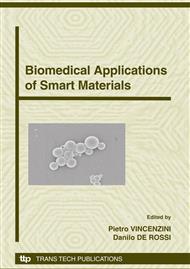p.117
p.125
p.131
p.135
p.139
p.144
p.148
p.154
p.160
Addition of Surface Function to Zirconia for Biomaterial Use
Abstract:
Due to the merits of zirconia ceramics such as high strength, toughness, and abrasion resistance, as well as chemical stability in vivo, yttria-stabilized tetragonal zirconia polycrystals (Y-TZP) are currently used in the femoral head of hip prostheses. However, this material has a limited range of use because it is a bioinert material that does not interact with bone tissue and thus does not easily integrate directly with bone. Therefore, addition of a material surface that enables the in vivo formation of a bone-like apatite layer that exhibits bioactivity and facilitates interactions and integration with bone tissue is desired. In addition, by developing a surface structure that enhances mechanical bonding, this material can be expected to be used as an alternative aggregate under load bearing conditions. In the present study, structural design of the material surface, addition of bioactivity using reagents treatment, confirmation of formation of the apatite layer using immersion in simulated body fluid, mechanical assessment, and wettability testing were conducted with the objective of controlling interactions between zirconia ceramics and the body.
Info:
Periodical:
Pages:
139-143
Citation:
Online since:
September 2008
Authors:
Keywords:
Price:
Сopyright:
© 2008 Trans Tech Publications Ltd. All Rights Reserved
Share:
Citation:


